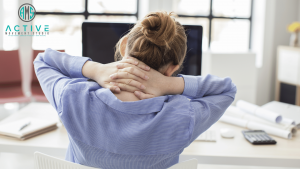How To Set Up Your Home Office
Posture Checklist
- Are your feet supported on the floor?
- Are your knees at a level lower than your hips?
- Is your weight distributed on your ischial tuberosity (mid-bum)?
- Are you maintaining a slight lumbar curve?
- Is your lumbar curve supported by your backrest?
- Are your elbows at around 90 degrees?
- Are your forearms parallel to the floor and supported by your desk?
- Are you keeping your elbows close to your sides?
- Is your head stacked directly over your shoulders?
Desk Set Up
- Does the top of your desk sit just slightly below the level of your elbows?
- Does your desk have enough space for fore-arm support?
- Is there enough leg room under your desk to stretch out your legs?
- Are all your frequently used items within comfortable reach?
Chair Set Up
- Is your chair seat adjustable?
- Does your chair backrest include a rounded lumbar support?
- Is the backrest and lumbar support adjustable in height?
- Can you adjust the angle of your backrest? (Optimal = 100-120 degrees)
- Can you adjust your seat pan? Tilt (for 100-120 degrees angle of hip) and Depth (for 2-3 fingers width clearance from front of chair and back of knee)?
- Does your chair have armrests? Are they restrictive?
- Does your chair have adequate and comfortable cushioning on the seat and backrest?
- When aligning your elbow position at the desk, do your feet reach the floor?
Are You Using a Laptop?
When using a laptop for an extended period of time we recommend the use of an external keyboard and mouse to optimise forearm support and decrease strain from prolonged downward bending of the neck or elevation of the shoulders and elbows.
Keep Active Keep Moving
Pick three stretches: every half an hour, performing each for 10 seconds.
Click the video below to see examples of easy to perform stretches from your home work station.
“Your best posture is your next posture”
It’s important to still stretch and move throughout the day. No workstation set-up can be used all day without taking its toll on the body. Extended periods in similar postures can lead to fatigue or overloading parts of the body.
The Physios at AMS are experts in diagnosing, treating and managing posture related back and neck injuries. Book in now to see a Physiotherapist and so we can make sure you are performing at your best at all times!
References:


